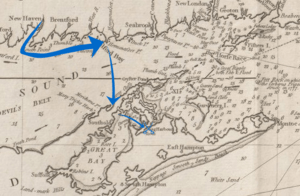Meigs Raid facts for kids
Quick facts for kids Meigs Raid |
|||||||
|---|---|---|---|---|---|---|---|
| Part of the American Revolutionary War | |||||||
 The "Old Burial Ground," next to the Whaler's Church, was a battle site during the raid. |
|||||||
|
|||||||
| Belligerents | |||||||
| Commanders and leaders | |||||||
| Return Jonathan Meigs | James Raymond (POW) | ||||||
| Strength | |||||||
| Expedition: 234 Assault: 130 |
Garrison: 70 men |
||||||
| Casualties and losses | |||||||
| None | 6 killed 90 captured 12 small boats sunk |
||||||
The Meigs Raid, also called the Battle of Sag Harbor, was a surprise attack by American forces during the American Revolutionary War. It happened on May 24, 1777, in Sag Harbor, New York. Colonel Return Jonathan Meigs led the American soldiers. They attacked a group of British Loyalist troops who were gathering supplies.
During the raid, six Loyalists were killed, and 90 were captured. The American forces had no casualties at all. This successful raid was a response to a British attack on Danbury, Connecticut, which had happened a month earlier.
The American expedition started in New Haven, Connecticut. They crossed Long Island Sound from Guilford on May 23. They even dragged their whaleboats across the North Fork of Long Island. The raid on Sag Harbor happened early the next morning, where they destroyed British boats and supplies.
Contents
Why Did the Raid Happen?
The American Revolutionary War was a tough fight. In 1776, the British took New York City after being forced out of Boston. However, General George Washington surprised them at Trenton and Princeton, making it hard for the British to hold onto New Jersey.
British Raids and American Response
In early 1777, the British controlled New York City and Long Island. The American Continental Army surrounded the city, blocking land routes in New Jersey, southern New York, and southwestern Connecticut.
British General William Howe began sending out raiding parties. These groups attacked American supply depots near New York City. A successful raid on Peekskill, New York, in March led to a bigger plan. This plan was to raid a large supply depot in Danbury, Connecticut.
Former New York governor William Tryon led the Danbury expedition. They landed in Fairfield, Connecticut, and reached Danbury on April 26. They destroyed many American provisions and supplies. Connecticut militia soldiers fought the British as they marched back to their ships. A notable fight happened on April 27 at Ridgefield.
General Samuel Holden Parsons, who was in charge of Connecticut's defenses, decided to strike back.
Sag Harbor's Importance
The Americans soon found out that a British group was gathering supplies at Sag Harbor, Long Island. British troops had taken over Sag Harbor after the Battle of Long Island in August 1776. They had built strong defenses there. These included earth walls and wooden fences called palisades on Meeting House Hill.
Sag Harbor was a great spot for the British to get supplies for the Royal Navy. The Navy used Gardiner's Bay as a place to anchor their ships. This allowed them to patrol the eastern part of Long Island Sound.
The British supply group at Sag Harbor had 12 small boats. A schooner with 12 guns protected these boats. The small boats had about 40 men. Sag Harbor itself had a group of 70 Loyalist soldiers. These soldiers were led by Captain James Raymond.
The Secret Journey to Sag Harbor
General Parsons chose Colonel Return Jonathan Meigs to lead the revenge mission. Meigs gathered 234 men from different regiments in New Haven.
On May 21, they rowed 13 whaleboats from New Haven to Guilford. Rough seas and strong winds kept them from crossing for two days. Finally, on the afternoon of May 23, they left Guilford. Two armed ships and one unarmed ship went with them.
Only 170 men made it across to Southold, New York, arriving around 6 pm. Meigs learned that most British soldiers in the area had gone to New York City. Only the small Loyalist force remained at Sag Harbor.
Meigs had his men carry 11 of the whaleboats across the North Fork to the bay. Then, 130 men launched these boats to cross the bay to Sag Harbor. By midnight, they had crossed the bay and landed about 4 miles (6 km) from the harbor. Meigs organized his men and marched to the harbor, arriving around 2 am.
The Attack on Sag Harbor

Colonel Meigs split his force into two groups. One group attacked the earth defenses. The other group went to the harbor to destroy British boats and collect supplies.
The land attack was very quiet. The soldiers used bayonets and only one shot was reportedly fired. As the Americans burned the boats, the British schooner started firing at them. It's not clear if the schooner itself was captured or destroyed.
The American raiders destroyed 12 boats. They captured 53 prisoners at the earthworks and another 37 at the wharf. Amazingly, the Americans had no casualties at all. The captured prisoners were taken back to Connecticut.
What Happened Next?
The Loyalist communities on Long Island tried to get back at the Americans for the raid. In May 1779, nine Loyalists crossed the sound. They captured Connecticut militia general Gold Selleck Silliman at his home and took him to Long Island.
In November 1779, Connecticut Patriots captured a judge on Long Island. They traded him for General Silliman in May 1780.
General Parsons organized another raid across Long Island Sound in August 1777. This one, against a Loyalist outpost at Setauket, was not successful.
Colonel Meigs was honored by the Second Continental Congress for his success. He received "an elegant sword." A stone was placed at the battle site on May 23, 1902, to remember the event.



